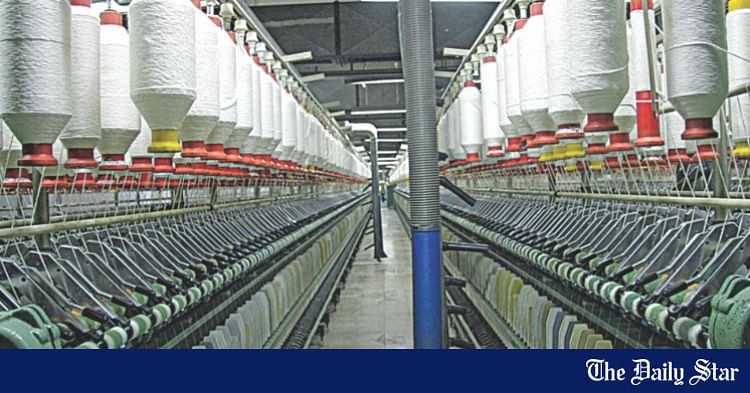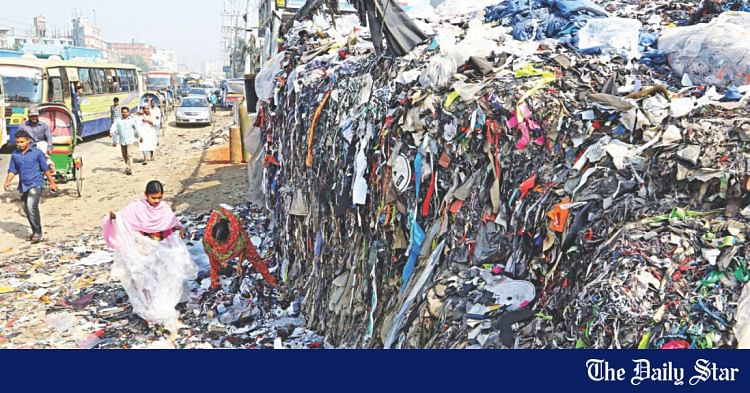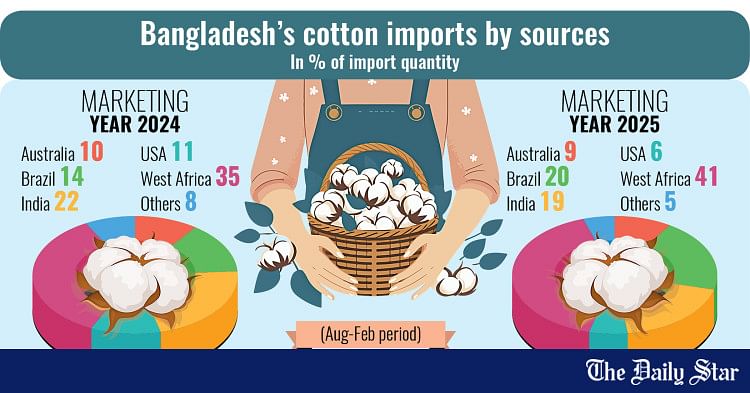Saif
Senior Member
- Joined
- Jan 24, 2024
- Messages
- 15,898
- Likes
- 7,990
- Nation

- Axis Group


RMG exports to EU jump 61pc
Bangladesh's readymade garment exports to the European Union (EU) recorded a robust 61-percent growth in January this year, staying ahead of the major competitors, including China, Vietnam, Turkey, and India. Apparel exports to the EU market in January 2025 fetched 1.91 billion euros, compar
RMG exports to EU jump 61pc
Monira Munni
Published :
Mar 20, 2025 00:30
Updated :
Mar 20, 2025 00:30

Bangladesh's readymade garment exports to the European Union (EU) recorded a robust 61-percent growth in January this year, staying ahead of the major competitors, including China, Vietnam, Turkey, and India.
Apparel exports to the EU market in January 2025 fetched 1.91 billion euros, compared to 1.18 billion euros earned in the same month last year, according to Eurostat data published on March 18. Eurostat is the statistical office of the EU.
Knitwear subsector exports to the 27-nation economic bloc in the first month of 2025 increased by 64.2 per cent to 1.14 billion euros, while woven garment exports surged by 56.3 per cent to 765.96 million euros.
Bangladesh's garment shipments to the EU in terms of volume witnessed over 58 per cent growth in January 2025, marking a turnover of 126.86 million kilograms from 80.25 million kilograms in the corresponding month of 2024, according to the data.
Exporters have attributed the rise to a number of factors, including rising global demand, shift of work orders from China, and duty-free market access, while local reasons are competitive pricing; enhanced capacity, efficiency, productivity, and workplace-safety compliance; and the production of quality goods.
The developments during last several years ensured buyers' confidence and trust and good business environment in the country, providing a boost to the main export trade.
The EU's total apparel imports in January 2025 stood at 8.28 billion euros, about 32 per cent higher than 6.28 billion euros logged in the corresponding month last year, the data revealed.
Among Bangladesh's main competitors, China recorded a 40.81 per cent growth in January 2025, while India, Pakistan, and Cambodia witnessed double-digit growth of 44.44 per cent, 32 per cent, and 72.43 per cent, respectively.
When asked, Bangladesh Knitwear Manufacturers and Exporters Association (BKMEA) former president Fazlul Hoque termed the growth encouraging as the industry is bouncing back.
Like the US, the EU market is also getting better after a long period of weaker position, while the base of comparison was also weak as January 2024 recorded negative growth, he noted.
With the improved economy, consumers are also purchasing apparels, resulting in rising demand, he explained.
Talking to The Financial Express, MA Rahim Feroz, vice-chairman of DBL Group, said the group's exports reached the highest $500 million for the first time as it dedicatedly enhanced both productivity and efficiency by installing modern technology while that of operators also increased.
Capacity, efficiency, and productivity have helped attain the growth overall, he noted.
Besides, work orders from China are also shifting to other garment-producing countries like Bangladesh, said Feroz, also a former leader of Bangladesh Garment Manufacturers and Exporters Association (BGMEA).
He noted that hundreds of small garment factories closed down during the last two years, while big ones are buying them and operating efficiently and professionally by complying with due diligence, which has also boosted the overall export growth.
"If the government can ensure an uninterrupted power supply, garment exports will reach $100 billion within the next three years," he added.
Both exporters opined that work orders are coming and the growth trend might sustain in 2025 as buyers got back their confidence and are sourcing more from Bangladesh.
According to Eurostat data, China earned 2.37 billion euros in January 2025 by exporting clothes to the EU against 1.68 billion euros in the same month last year.
The EU's imports from Turkey recorded a slow growth of 5.41 per cent to 874.09 million euros in January 2025. Vietnam recorded a 34.27 per cent growth, earning 398.56 million euros that month.
Pakistan and Cambodia fetched 347.71 million euros and 420.86 million euros, respectively, in January this year from the EU market. The EU imported apparels worth 397.70 million euros from India in January 2025, which was 44.44 per cent higher than the earnings in the same month last year.
In the meantime, RMG exports to the United States, the single-largest destination for Bangladesh, grew by 45.9 per cent to $799.65 million in January 2025, according to data from OTEXA, an affiliate of the US Department of Commerce.
In January last year, clothing exports from Bangladesh to the US market stood at $547.95 million.
Exporters, however, noted that though the global demand has been improving in recent months, Bangladesh is failing to grab the opportunity fully as its competitive edges are eroding mainly because of high utility prices, poor gas supply, banking issues, and labour unrest.
Monira Munni
Published :
Mar 20, 2025 00:30
Updated :
Mar 20, 2025 00:30
Bangladesh's readymade garment exports to the European Union (EU) recorded a robust 61-percent growth in January this year, staying ahead of the major competitors, including China, Vietnam, Turkey, and India.
Apparel exports to the EU market in January 2025 fetched 1.91 billion euros, compared to 1.18 billion euros earned in the same month last year, according to Eurostat data published on March 18. Eurostat is the statistical office of the EU.
Knitwear subsector exports to the 27-nation economic bloc in the first month of 2025 increased by 64.2 per cent to 1.14 billion euros, while woven garment exports surged by 56.3 per cent to 765.96 million euros.
Bangladesh's garment shipments to the EU in terms of volume witnessed over 58 per cent growth in January 2025, marking a turnover of 126.86 million kilograms from 80.25 million kilograms in the corresponding month of 2024, according to the data.
Exporters have attributed the rise to a number of factors, including rising global demand, shift of work orders from China, and duty-free market access, while local reasons are competitive pricing; enhanced capacity, efficiency, productivity, and workplace-safety compliance; and the production of quality goods.
The developments during last several years ensured buyers' confidence and trust and good business environment in the country, providing a boost to the main export trade.
The EU's total apparel imports in January 2025 stood at 8.28 billion euros, about 32 per cent higher than 6.28 billion euros logged in the corresponding month last year, the data revealed.
Among Bangladesh's main competitors, China recorded a 40.81 per cent growth in January 2025, while India, Pakistan, and Cambodia witnessed double-digit growth of 44.44 per cent, 32 per cent, and 72.43 per cent, respectively.
When asked, Bangladesh Knitwear Manufacturers and Exporters Association (BKMEA) former president Fazlul Hoque termed the growth encouraging as the industry is bouncing back.
Like the US, the EU market is also getting better after a long period of weaker position, while the base of comparison was also weak as January 2024 recorded negative growth, he noted.
With the improved economy, consumers are also purchasing apparels, resulting in rising demand, he explained.
Talking to The Financial Express, MA Rahim Feroz, vice-chairman of DBL Group, said the group's exports reached the highest $500 million for the first time as it dedicatedly enhanced both productivity and efficiency by installing modern technology while that of operators also increased.
Capacity, efficiency, and productivity have helped attain the growth overall, he noted.
Besides, work orders from China are also shifting to other garment-producing countries like Bangladesh, said Feroz, also a former leader of Bangladesh Garment Manufacturers and Exporters Association (BGMEA).
He noted that hundreds of small garment factories closed down during the last two years, while big ones are buying them and operating efficiently and professionally by complying with due diligence, which has also boosted the overall export growth.
"If the government can ensure an uninterrupted power supply, garment exports will reach $100 billion within the next three years," he added.
Both exporters opined that work orders are coming and the growth trend might sustain in 2025 as buyers got back their confidence and are sourcing more from Bangladesh.
According to Eurostat data, China earned 2.37 billion euros in January 2025 by exporting clothes to the EU against 1.68 billion euros in the same month last year.
The EU's imports from Turkey recorded a slow growth of 5.41 per cent to 874.09 million euros in January 2025. Vietnam recorded a 34.27 per cent growth, earning 398.56 million euros that month.
Pakistan and Cambodia fetched 347.71 million euros and 420.86 million euros, respectively, in January this year from the EU market. The EU imported apparels worth 397.70 million euros from India in January 2025, which was 44.44 per cent higher than the earnings in the same month last year.
In the meantime, RMG exports to the United States, the single-largest destination for Bangladesh, grew by 45.9 per cent to $799.65 million in January 2025, according to data from OTEXA, an affiliate of the US Department of Commerce.
In January last year, clothing exports from Bangladesh to the US market stood at $547.95 million.
Exporters, however, noted that though the global demand has been improving in recent months, Bangladesh is failing to grab the opportunity fully as its competitive edges are eroding mainly because of high utility prices, poor gas supply, banking issues, and labour unrest.









































